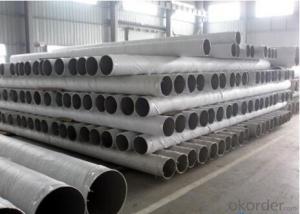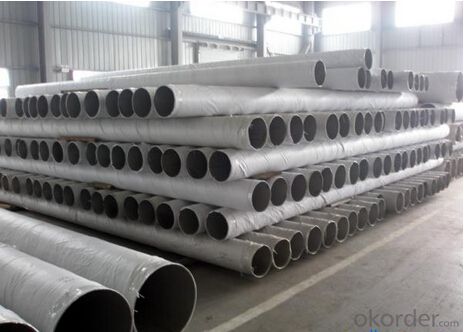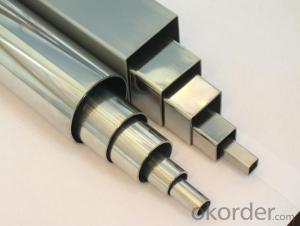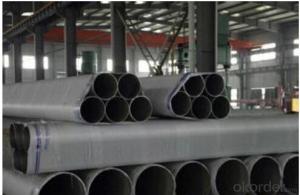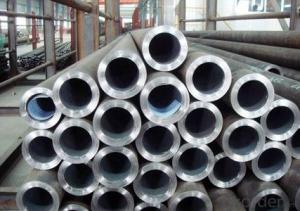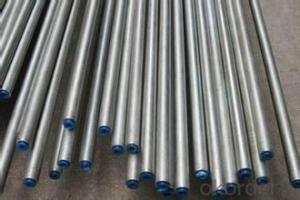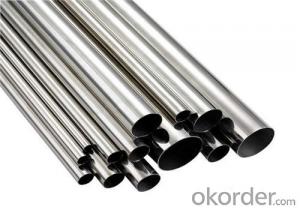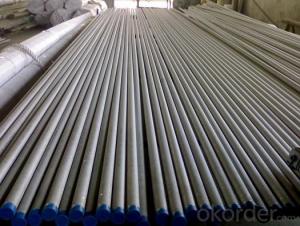Stainless Steel Seamles Pipe 304 ASTM A312
- Loading Port:
- Ningbo
- Payment Terms:
- TT or LC
- Min Order Qty:
- 1 m.t.
- Supply Capability:
- 5000 m.t./month
OKorder Service Pledge
OKorder Financial Service
You Might Also Like
1、Structure of Stainless Steel Seamles Pipe 304 ASTM A312 Description:
Stainless seamless pipe is formed by drawing a solid billet over a piercing rod to create the hollow shell. As the manufacturing process does not include any welding, seamless pipes are perceived to be stronger and more reliable. Historically seamless pipe was regarded as withstanding pressure better than other types, and was often more easily available than welded pipe.
2、Main Features of the Stainless Steel Seamles Pipe 304 ASTM A312:
• High manufacturing accuracy
• High strength
• Small inertia resistance
• Strong heat dissipation ability
• Good visual effect
•Reasonable price
3、Stainless Steel Seamles Pipe 304 ASTM A312 Images:
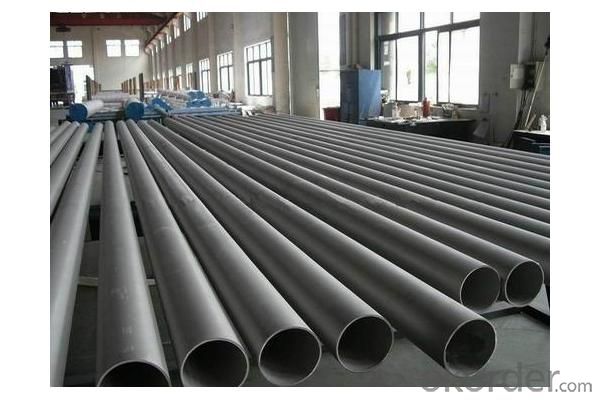
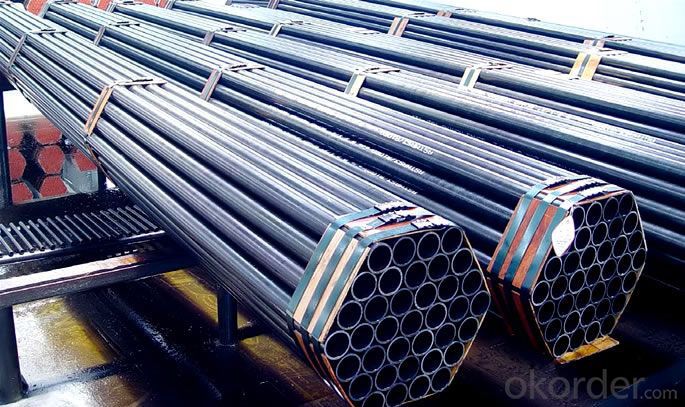
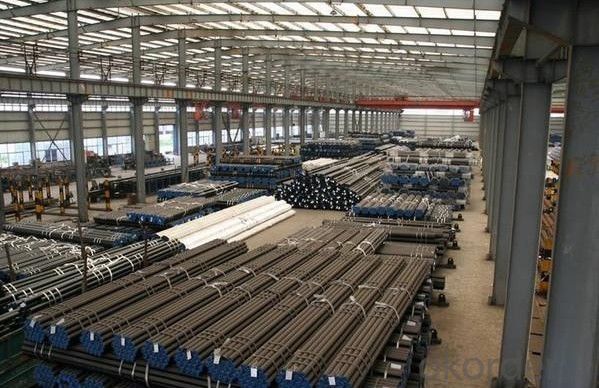
4、Stainless Steel Seamles Pipe 304 ASTM A312 Specification:
Experienced Lists of Standard |
Applicable Code No. |
Steel Grade |
ASTM |
A213, A269, A312, A789, A790, B677, A268 | TP304/L/H, TP310/S/H, TP316/L/H/Ti, TP317/L, TP321/H, TP347/H, S31803, S32205, S32750, S32304, S31500, TP904L, TP410, TP430, TP405, TP409/409L |
ASME |
SA213, SA312, SA789, SA790, SB677 | TP304/L/H, TP310/S/H, TP316/L/H/Ti, TP317/L, TP321/H, TP347/H, S31803, S32205, S32750, S32304, S31500, TP904L |
JIS |
JIS G3459, JIS G3463 | SUS 304TB, SUS304HTB, SUS304LTB, SUS310TB, SUS310STB, SUS316TB, SUS316LTB, SUS316TiTB, SUS317TB, SUS317LTB, SUS321TB, SUS321HTB, SUS347TB, SUS347HTB |
EN & DIN | EN 10216-5, DIN 17456, DIN 17458 | 1.4301, 1.4307, 1.4541, 1.4878, 1.4401, 1.4404,1.4571,1.4550,1.4438, 1.4436,1.4435, 1.4462, 1.4539, 1.4912, 1.4362 |
GB&GB/T | G B13296 G B/ T14976 | 0Cr18Ni9,00Cr19Ni10,0Cr18Ni10Ti,0Cr18Ni11Nb,0Cr17Ni12Mo2,000Cr17Ni14Mo2,0Cr18 |
Type |
O.D. |
W.T. |
Length | Bending Radius | Application Specification |
S.S Seamless Tubing |
3.17mm – 101.6mm |
0.5mm – 25.4mm |
Max. 22m |
/ | A213, A269, A511, A789; SA213, SA789, B677, SB677; JIS G3463; EN 10216-5 |
S.S. Seamless Pipe |
10.29mm – 355.70mm |
0.89mm – 50.0mm |
Max. 18m |
/ | A312, A790, SA312, SA790, JIS G3459, EN 10216-5 |
S.S. Seamless U-tube |
15.88mm – 76.1mm |
0.89mm – 7.14mm |
Max. 25m |
From 1.5 x OD To 1000mm | A213, A789, SA213, SA789, B677, SB677, JIS G3463, EN 10216-5, SA688 |
Testing:
(1) Hydro-Static Test
(2) Non-Destructive Test
(3) Ultrasonic Test
(4)Eddy-Current Test
5、FAQ of Stainless Steel Seamles Pipe 304 ASTM A312:
①How is the quality of your products?
Our products are manufactured strictly according to national and internaional standard, and we take a test on every pipe before delivered out. If you want see our quality certifications and all kinds of testing report, please just ask us for it.
Guaranteed: If products’ quality don’t accord to discription as we give or the promise before you place order, we promise 100% refund.
②How about price?
Yes, we are factory and be able to give you lowest price below market one, and we have a policy that “ for saving time and absolutely honest business attitude, we quote as lowest as possible for any customer, and discount can be given according to quantity”,if you like bargain and factory price is not low enough as you think, just don’t waste your time.Please trust the quotation we would give you, it is professional one.
③Why should you chose us?
Chose happens because of quality, then price, We can give you both.Additionally, we can also offer professional products inquiry, products knowledge train(for agents), smooth goods delivery, exellent customer solution proposals.Our service formula: good quality+good price+good service=customer’s trust
SGS test is available, customer inspection before shipping is welcome, third party inspection is no problem.
Any question, pls feel free to contact us !
- Q: Are stainless steel pipes suitable for sewage treatment plants?
- Yes, stainless steel pipes are suitable for sewage treatment plants. Stainless steel is a highly durable and corrosion-resistant material, making it well-suited for the harsh and corrosive environment found in sewage treatment plants. The high resistance to corrosion prevents the pipes from deteriorating over time, ensuring a longer lifespan and reducing the need for frequent maintenance or replacements. Additionally, stainless steel pipes have excellent hygienic properties, which is crucial for sewage treatment plants to maintain proper sanitation. The smooth surface of stainless steel pipes prevents the accumulation of bacteria, biofilm, and other contaminants, making it easier to clean and maintain a high level of cleanliness. Furthermore, stainless steel is environmentally friendly as it is 100% recyclable, contributing to sustainable practices in sewage treatment plants. Overall, stainless steel pipes are a reliable and suitable choice for sewage treatment plants due to their durability, corrosion resistance, hygienic properties, and environmental friendliness.
- Q: Can stainless steel pipes be used for chemical pumps?
- Yes, stainless steel pipes can be used for chemical pumps. Stainless steel is known for its excellent corrosion resistance, making it suitable for handling various chemicals. It can withstand high temperatures and pressures, ensuring reliable performance in chemically aggressive environments. Stainless steel pipes are commonly used in chemical processing industries, wastewater treatment plants, and other applications involving the transfer of corrosive liquids or gases.
- Q: Are stainless steel pipes suitable for oil and gas applications?
- Yes, stainless steel pipes are suitable for oil and gas applications. Stainless steel is highly resistant to corrosion, making it ideal for transporting and storing oil and gas, which often contain corrosive elements. Stainless steel pipes also have high strength and durability, ensuring they can withstand high-pressure conditions and harsh environments. Additionally, stainless steel is easy to clean and maintain, reducing the risk of contamination in oil and gas operations. Overall, stainless steel pipes are a reliable and cost-effective choice for oil and gas applications.
- Q: Can stainless steel pipes be used in underground installations?
- Indeed, underground installations can utilize stainless steel pipes. The notable attribute of stainless steel lies in its resistance to corrosion, rendering it a fitting choice for underground applications where pipes encounter moisture and other corrosive elements. In addition, stainless steel pipes are renowned for their durability, longevity, and ability to endure high pressure and extreme temperatures. Moreover, stainless steel exhibits resistance to harm caused by movements in the subterranean soil. Henceforth, it stands as a dependable option for underground installations encompassing water and gas supply systems, sewage systems, and industrial pipelines.
- Q: Can stainless steel pipes be powder coated?
- Yes, stainless steel pipes can be powder coated. Powder coating is a durable and protective finish that can be applied to stainless steel pipes to enhance their appearance and provide additional corrosion resistance.
- Q: What is the difference between 316 and 316H stainless steel pipes?
- The main difference between 316 and 316H stainless steel pipes lies in their carbon content. 316 stainless steel pipes have a maximum carbon content of 0.08%, which makes them suitable for applications where corrosion resistance is important, such as in marine environments. They are also known for their excellent welding and forming properties, making them a popular choice in various industries. On the other hand, 316H stainless steel pipes have a higher carbon content, typically around 0.04-0.10%. This increased carbon content provides improved high-temperature strength and creep resistance, making them suitable for applications where the pipes will be subjected to elevated temperatures, such as in high-pressure steam systems or in the petrochemical industry. In summary, while both 316 and 316H stainless steel pipes offer good corrosion resistance and overall performance, the 316H variant is specifically designed to withstand higher temperatures and offer better strength properties.
- Q: What is the difference between seamless and cold-rolled stainless steel pipes?
- The main difference between seamless and cold-rolled stainless steel pipes lies in their manufacturing process and the resulting characteristics. Seamless stainless steel pipes are produced by piercing a solid cylindrical billet of stainless steel and then processing it through various steps such as elongation and reduction to achieve the desired size and shape. This process ensures that the pipe has a smooth and even surface, without any welded seams. As a result, seamless stainless steel pipes exhibit superior strength, durability, and resistance to corrosion. They are also known for their ability to withstand high pressure and temperature conditions, making them suitable for a wide range of applications, including oil and gas pipelines, chemical processing, and power generation. On the other hand, cold-rolled stainless steel pipes are manufactured by rolling stainless steel sheets or strips at room temperature. This process involves passing the material through a series of rollers to reduce its thickness and shape it into a cylindrical form. Unlike seamless pipes, cold-rolled pipes have welded seams that may be visible on the surface. While these seams can potentially weaken the pipe, they can be mitigated by applying additional processes such as heat treatment or cold working to enhance the strength and integrity of the weld. The choice between seamless and cold-rolled stainless steel pipes depends on the specific requirements of the application. Seamless pipes are generally preferred when high strength, corrosion resistance, and pressure resistance are critical, especially in industries where leaks or failure can have severe consequences. Cold-rolled pipes, on the other hand, may be more suitable for applications where cost-effectiveness and moderate performance are sufficient, such as certain plumbing systems or decorative purposes. In summary, seamless stainless steel pipes are produced without welded seams, offering superior strength, durability, and resistance to corrosion, making them ideal for demanding applications. Cold-rolled stainless steel pipes, with visible welded seams, are generally more cost-effective and suitable for less demanding applications that don't require the same level of strength and corrosion resistance.
- Q: Are stainless steel pipes suitable for extreme temperatures?
- Indeed, extreme temperatures are well-suited for stainless steel pipes. Renowned for their exceptional heat resistance properties, stainless steel is a favored choice for applications involving elevated temperatures. With the ability to endure both exceedingly high and low temperatures, stainless steel pipes prove their suitability across a broad spectrum of industries, including oil and gas, chemical processing, power generation, and aerospace. The high levels of chromium and nickel found in stainless steel alloys significantly contribute to their resistance against corrosion and oxidation, allowing them to maintain their structural integrity even in the face of extreme temperature conditions. Furthermore, stainless steel pipes exhibit minimal expansion and contraction rates, ensuring their resilience against thermal cycling without any notable distortion or harm. In summary, stainless steel pipes stand as a dependable and long-lasting option for managing extreme temperatures.
- Q: Can stainless steel pipes be insulated with polyethylene-terephthalate glycol?
- No, stainless steel pipes cannot be insulated with polyethylene-terephthalate glycol.
- Q: What are the cost considerations for stainless steel pipes?
- The cost considerations for stainless steel pipes include the initial purchase price, installation costs, maintenance expenses, and potential long-term savings due to their durability and corrosion resistance. Additionally, factors such as the grade, size, and quantity of pipes needed and any additional fabrication or customization requirements can also impact the overall cost.
Send your message to us
Stainless Steel Seamles Pipe 304 ASTM A312
- Loading Port:
- Ningbo
- Payment Terms:
- TT or LC
- Min Order Qty:
- 1 m.t.
- Supply Capability:
- 5000 m.t./month
OKorder Service Pledge
OKorder Financial Service
Similar products
Hot products
Hot Searches
Related keywords
